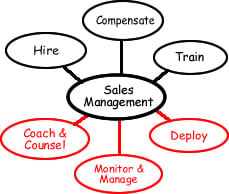This article has been selected for DeFinis Communications’ “Sales Coaching: Top Tips for Increased Productivity” Blog Carnival. You can enjoy even more posts from other exceptional bloggers at their website.
Sales managers have six basic jobs—hire, compensate, train, deploy, monitor and manage, and coach and counsel—and they generally fail at the last three.
 If hiring, training and compensating are the science behind sales management, then deployment, monitoring and managing, and coaching and counseling are the art. Manage on the basis of both the art and science, and you’ll drive more revenue.
If hiring, training and compensating are the science behind sales management, then deployment, monitoring and managing, and coaching and counseling are the art. Manage on the basis of both the art and science, and you’ll drive more revenue.
Based on the chapter, The Truth About Sales, from my new book, The Truth About Leads, this article looks at improving performance in the three “art of sales management” areas.
Sales Deployment
Most companies deploy reps in traditional ways. Small and mid-sized companies typically assign by geographic territories. Larger organizations may deploy salespeople based on vertical industries. While this works organizationally, it requires little to no critical thinking.
Ideal deployment puts the best rep with the best prospect at the best time. Each rep is a unique individual offering a specific personality, skills and background. What works in one situation might not work in another. The manager must match the rep to the opportunity.
If Joe is your top salesperson, should he work Company A just because it’s in his territory? Maybe not, especially if Mary has special knowledge of the company's industry or has previous contacts with its chief decision-maker. While Mary may not be the best rep, she is the best rep for this prospect.
Monitoring and Managing
Ideally, a manager helps reps prioritize time so the best opportunities get disproportionately more time. Deals that may close the next quarter should be given the right amount of attention to move them along. Note: I’m not suggesting working only the hottest opportunities! Reps and managers must invest in long-term opportunities that could represent more revenue and profitability.
A rep should have visibility into no more than 30 to 40 accounts at a time and should be focused on a short list of just 8 to 12 accounts a month. Four to six of these may require up to 50 percent of a rep’s time, and four to six accounts may require another 25 percent. Some long-term opportunities can be worked into the equation with a call or email every few weeks. This ensures continual pipeline movement and prevents focusing too much time on short-term opportunities at the expense of long-term ones.
Coaching and Counseling
Many think coaching and counseling are the same. Not true.
Coaching is working with an individual capable of doing the job who doesn’t have the knowledge to do it properly. It is an ongoing educational process to help achieve full potential.
Counseling has a finite number of steps and is focused on those who seemingly have the tools to perform better, but who aren't using them.
There is good coaching and bad coaching. If a manager uses one selling methodology (i.e., Solution Selling®), then discussions with reps will include the following:
Pain: Is there addressable pain?
Power: Are we connected to the power?
Vision: Do we understand the power’s solution vision?
Value: How valuable is a solution?
Control: Do we have any control over the process and can we win?
Here is an example of a counseling situation: Steve is bright, affable and capable of being a top rep. You've coached and trained him, but he repeatedly fails to meet quota. Is Steve putting in fewer hours than he should be or failing to follow up on qualified leads? The truth is after a certain point it does not matter.
Many managers are unsure of how to counsel, but it can be completed in four clear steps:
1. Identify the problem.
2. Identify the resolution.
3. Identify by when the resolution must occur.
4. Specify the outcome if the problem isn't resolved.
Visualize the sales team distributed into three unequal groups. Those in the top section (about 10 to 20%) care deeply about staying there. Those in the middle (60 to 80%) are satisfied with staying in the middle but don’t want to fall to the bottom. Those in the bottom are fine with staying there.
If counseling does not work with the bottom group, termination is the likely outcome. This changes the dynamics as the new bottom will be comprised of previous mid-level performers with a greater desire to improve and move up. A good manager should spend more time pushing from the bottom up to improve overall performance.
Conclusion
It’s easy to overlook the “art of sales management” elements—deployment, monitoring and managing, coaching and counseling—critical to optimizing performance.
Add these steps, and your reps’ chances for success are greatly increased. This will in turn positively impact your company's revenue.
By Dan McDade
Topics: Sales Process, B2B Sales, Sales Training, Increase Sales




